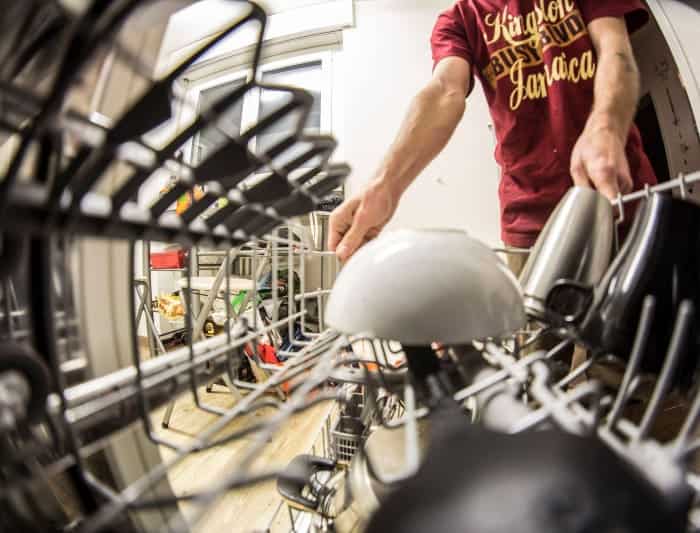Do you love the convenience of a dishwasher but don’t want to invest in a built-in one? There are not a lot of things in the world that can look as discouraging as a pile of unwashed dishes. After devouring a fantastic meal, cleaning up that stack of dirty pots, pans, plates, and utensils is the last thing you want. Of course, you can always throw them in the dishwasher. But what if you don’t have one?
Portable dishwashers can be the perfect solution for you! With the option to convert them into a built-in unit, you can enjoy the benefits of a permanent dishwasher without the hassle of installation.
Dishwashers have been a permanent home fixture for so long that it’s easy to forget about some people not having them. We’re not talking about impoverished households in developing countries, either. We’re talking about smaller dwelling units like a studio-type or a one-bedroom apartment. Space is such a premium in those homes, and most of the time, the dishwasher is the appliance that gets nixed.
The good news is that you don’t have to settle with handwashing a mountain of dishes. Whether your space is big or small, a portable dishwasher can be your new best friend.
In this article, we will guide you on installing a portable dishwasher and converting it into a built-in unit by connecting it to your sink drain or garbage disposal unit. We will also discuss the important aspects to consider when making the switch, such as the drain line. Whether you are renovating your kitchen or simply looking for an efficient dishwashing solution, this article has got you covered!
How can a dishwasher become portable?
If you’ve always thought of dishwashers as large boxes that stay in place under the kitchen counter, you’re not alone. Many people, especially those with little space, have usually never heard of this portable appliance.
What makes the dishwasher portable is the set of rollers underneath that allow you to move and store the unit everywhere. These rollers make it easy for you to start a dishwasher load anywhere and store it away when not in use. They’re not as big as their permanent counterparts, but they’re able to hold a decent amount of load.
There are also countertop dishwashers, whose name suggest precisely how they can be stored: on the countertop. Even though they’re technically “portable” because you can move (or lift) them around, stores always market them as a “countertop” variety.
How do portable dishwashers work?
Portable dishwashers work pretty much the same as permanent ones. You load your plates inside, deposit the soap, and let it run.
Aside from the fact that one has wheels underneath and the other does not, the main difference lies in how the unit gets water. Permanent ones are connected directly to the sink’s water and drain lines. Because of this connection, you can use both the sink and the dishwasher simultaneously without impeding the other.
Meanwhile, a portable dishwasher has a water supply hose that connects to the sink faucet. The hose treats the faucet as a water pipe, which means you cannot use the sink at all while the dishwasher is running.
Making the switch from portable to permanent
If you already have a portable unit and you’re ready to upgrade to a permanent one, you’re in for a treat. You don’t have to get rid of your current dishwasher. With some basic home improvement know-how, you can turn your portable dishwasher into a permanent one.
The first thing you must do is to remove the casters from underneath your dishwasher. Because your appliance is transforming from portable to permanent, it doesn’t need to roll around anymore. Search the dishwasher’s manual or tilt the unit to its side to learn how to remove the rollers.
Next, grab a dishwasher installation kit from your nearest hardware store. Make sure you’re purchasing a kit specifically for your dishwasher make and model, or you risk having incompatible parts. Once you have your set, use the pieces to change the dishwasher’s water and drain fittings. The default ones are not meant to connect directly to a pipe, so fitting them with parts from the installation kit ensures compatibility.
Lastly, make sure that your dishwasher’s new home has proper access to a power supply. You want to make sure it’s not so far that the power cord is outstretched; you also don’t want it so close that it becomes dangerous in case of a leak.
Other considerations
Once you find the space and get the proper parts to convert your portable appliance to a permanent one, you’re pretty much in the home stretch. Though it wouldn’t hurt to consider your dishwasher’s noise level. If you have a noisier unit, you might want to think about controlling the noise properly. Ensuring proper access to the dishwasher’s interface is also essential, especially when storing it under the counter.
Final thoughts
You don’t have to settle with not having a dishwasher when there’s a way for you to have one. Not only is it convenient to have a device washing the dishes for you, but it’s also better for the environment. Don’t let a permanent dishwasher’s costs and space requirements discourage you. Portable dishwashers are a legitimate option, and they are just as helpful.






